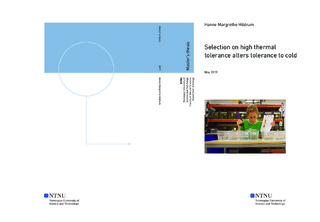| dc.contributor.advisor | Jutfelt, Fredrik | |
| dc.contributor.advisor | Morgan, Rachael | |
| dc.contributor.advisor | Finnøen, Mette Helene | |
| dc.contributor.advisor | Wright, Jonathan | |
| dc.contributor.author | Hildrum, Hanne Margrethe | |
| dc.date.accessioned | 2019-09-22T14:00:16Z | |
| dc.date.available | 2019-09-22T14:00:16Z | |
| dc.date.issued | 2019 | |
| dc.identifier.uri | http://hdl.handle.net/11250/2618098 | |
| dc.description.abstract | Klimaendringer vil føre til økning i vanntemperaturer og intensitet av hetebølger. Dette vil utfordre ektoderme fiskers indre fysiologi og populasjonsutbredelse, delvis avhengig av deres temperatur-toleranse. Et vanlig mål på toleranse mot ekstreme temperaturer er kritisk termisk metode (CTM), som både brukes om en metode og en parameter på et individs kritiske maksimale (CTmax) og minimale (CTmin) temperatur. Tidligere studier har testet CTmax og CTmin på uselekterte utvalg fisker og ofte målt effekten av akklimatisering på evnen til å tåle ekstreme temperaturer. Denne studien er den først til å undersøke om kunstig seleksjon for CTmax over generasjoner også gir endringer i CTmin. Dette ble gjennomført på fjerdegenerasjon av sebrafisker (Danio rerio, n=204), hvor disse temperatur-ekstremitetene ble sammenlignet på individnivå. Resultatene viste negativ korrelasjon mellom CTmin og høy CTmax, noe som tyder på at noen individer hadde et bredt temperaturspenn mens andre hadde smalt. Linjen tidligere selektert for lav CTmax hadde det smaleste temperaturspennet grunnet lav CTmax og høy CTmin. Overraskende, kontroll-linjen av ikke-selekterte, tilfeldig avlede sebrafisker hadde lavest CTmin (9.97 °C). Linjen selektert for høy CTmax hadde fortsatt høyest CTmax (41.62 °C) i denne generasjonen, men var ikke signifikant forskjellig fra kontrollgruppen i hverken CTmax, CTmin eller temperaturspenn. Resultatene viser at retningsbestemt seleksjon mot lav prestasjon i én ende av temperaturtoleransekurven (her: CTmax) ikke indikerer bedre prestasjon i den andre enden (her: CTmin). | |
| dc.description.abstract | Climate change will lead to increased water temperatures and heat wave intensity. For ectothermal fish, this will challenge their internal physiology and population distribution, depending partly on their thermal tolerance. A commonly used measure of tolerance to extreme temperatures is the critical thermal method (CTM), both a method and a parameter of an individual’s critical thermal maximum (CTmax) and minimum (CTmin). Previous studies have tested CTmax and CTmin in non-selected samples of fish, and often measured the effect of acclimation on thermal performance. The present study is the first to investigate whether artificial selection on CTmax over generations has also caused a change in CTmin. This was conducted on fourth generation of zebrafish (Danio rerio, n=204), where these thermal limits were compared on an individual level. A negative correlation was found between CTmin and high CTmax, meaning that some individuals had a wide thermal scope while others had narrow. The line previously selected on low CTmax had the narrowest scope, due to low CTmax and high CTmin. Surprisingly, the control line of non-selected, randomly bred zebrafish had the lowest CTmin (9.97 °C). The line selected on high CTmax still got the highest CTmax (41.62 °C) in this generation but were not significantly different from the control line in neither CTmax, CTmin nor scope. The results show that directional selection towards low performance in one end of the thermal tolerance curve (here: CTmax) does not indicate better performance at the other end (here: CTmin). | |
| dc.language | eng | |
| dc.publisher | NTNU | |
| dc.title | Selection on high thermal tolerance alters tolerance to cold | |
| dc.type | Master thesis | |
